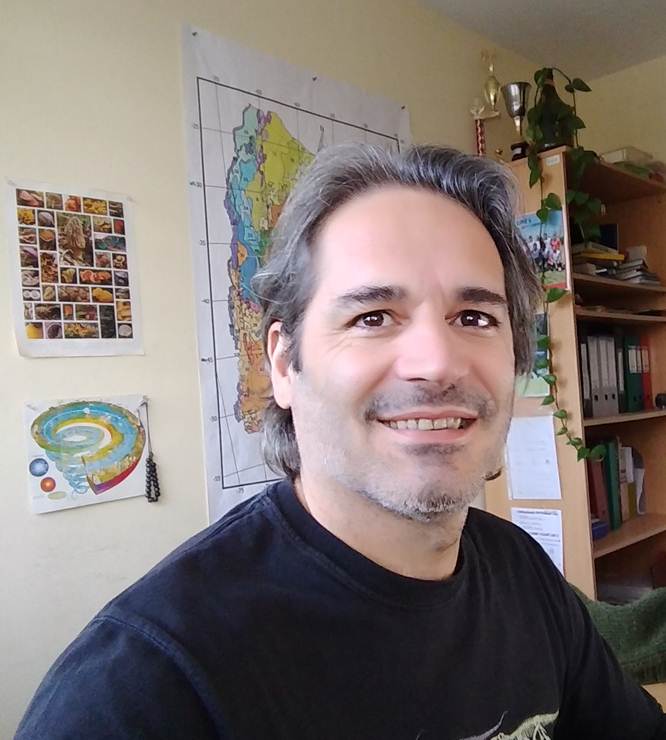
Investigador Principal CONICET. Profesor Titular de la UNC
E-mail:curcelay@imbiv.unc.edu.ar
Títulos: Doctor en Ciencias Biológicas, Magíster en Educación en Ciencias y Biólogo
Área: SISTEMÁTICA, TAXONOMÍA Y FLORÍSTICA. Línea de Investigación: Micología
Resumen de proyecto de investigación
Investigaciones sobre las diversidad de hongos y sus relaciones con la composición de las comunidades vegetales y los procesos ecosistémicos. En general, los estudios se enmarcan en contextos de cambios ambientales, tales como los cambios en el uso de la tierra y las invasiones biológicas.
Publicaciones (últimos cinco años)
Longo, S., Nouhra, E., Tecco, P. A., & Urcelay, C. 2020. Functional stability of mycorrhizal interactions in
woody natives and aliens facing fire disturbance. Plant Ecology 221: 321-331.
Marro, N., Cofré, N., Grilli, G., Alvarez, C., Labuckas, D., Maestri, D., & Urcelay, C. 2020. Soybean yield,
protein content and oil quality in response to interaction of arbuscular mycorrhizal fungi and native
microbial populations from mono-and rotation-cropped soils. Applied Soil Ecology, 152: 103575.
Borda, V., Cofré N., Longo S., Grilli G. & Urcelay C. 2020. El “siempreverde” (Ligustrum lucidum) ¿altera
la composición de las comunidades de hongos micorrícicos arbusculares en el chaco serrano?
Ecología Austral 30: 282-294.
Robledo, GL, Palacio M, Urcelay C, Vasco-Palacios AM, Crespo E, Popoff O, Põldmaa K, Ryvarden L &
Costa-Rezende DH. 2020. Mystery unveiled: Diacanthodes Singer – a lineage within the core
polyporoid clade. Systematics and Biodiversity 18: 538-556.
Motato-Vásquez, V., Gugliotta, A. M., Rajchenberg, M., Catania, M., Urcelay, C., & Robledo, G. 2020. New
insights on Bjerkandera (Phanerochaetaceae, Polyporales) in the Neotropics with description of
Bjerkandera albocinerea based on morphological and molecular evidence. Plant Ecology and
Evolution, 153: 229-245.
Urcelay, C. & Austin A. 2020. Exotic plants get a little help from their friends. Science 368: 934-936
Cofré, N., Becerra, A. G., Marro, N., Domínguez, L., & Urcelay, C. 2020. Soybean growth and foliar
phosphorus concentration mediated by arbuscular mycorrhizal fungi from soils under different no-till
cropping systems. Rhizosphere, 16, 100254.
Piloni, R., Daga, C. Urcelay, C. & Moyano E.L. (2021). Experimental investigation on fast pyrolysis of
freshwater algae. Prospects for alternative bio-fuel production. Algal Research, 54: 102206
Aguirre, F., Nouhra, E., & Urcelay, C. (2021). Native and non-native mammals disperse exotic
ectomycorrhizal fungi at long distances from pine plantations. Fungal Ecology, 49, 101012.
Borda, V., Longo, S., Marro, N., & Urcelay, C. (2021). The global invader Ligustrum lucidum accumulates
beneficial arbuscular mycorrhizal fungi in a novel range. Plant Ecology, 222: 397-408.
Salvador-Montoya, C. A., Elias, S. G., Popoff, O. F., Robledo, G. L., Urcelay, C., Góes-Neto, A., Martínez S.
& Drechsler-Santos, E. R. (2022). Neotropical Studies on Hymenochaetaceae: Unveiling the
Diversity and Endemicity of Phellinotus. Journal of Fungi, 8: 216.
https://doi.org/10.3390/jof8030216
Marro, N., Grilli, G., Soteras, F., Caccia, M., Longo, S., Cofré, N., Borda, V., Burni, M., Janoušková, M. &
Urcelay, C. (2022). The effects of arbuscular mycorrhizal fungal species and taxonomic groups on
stressed and unstressed plants: a global meta-analysis. New Phytologist 235: 320-332.
Borda, V., Reinhart, K. O., Ortega, M. G., Burni, M., & Urcelay, C. (2022). Roots of invasive woody plants
produce more diverse flavonoids than non-invasive taxa, a global analysis. Biological Invasions, 24:
2757-2768.
Robledo, G., Urcelay, C., & Popoff, O. (2022). Mario Rajchenberg: un maestro y referente de la Micología
en Sudamérica. Lilloa, 3-5. (Artículo editorial, sin evaluación).
Urcelay, C., Grilli, G., & Marro, N. A. (2022). Trait-based approaches in arbuscular mycorrhizal fungi need to distinguish between response and effect traits. IMS newsletter 3: 19 – 21.
Campi, M. G., Azevedo-Olivera, C., Costa-Rezende, D., Cano, Y. M., Morera, G., Urcelay, C., Drechsler-
Santos E. R. & Robledo, G. L. (2022). What are the Laetiporus species present in southern South
America?. Lilloa, 193-218.
Grilli, G., Cofré, N., Marro, N., Videla, M., & Urcelay, C. (2023). Shifts from conventional horticulture to
agroecology impacts soil fungal diversity in Central Argentina. Mycological Progress, 22: 20.
Caccia, M., Urcelay, C., & Videla, M. (2023). Complex relationships between lettuce (Lactuca sativa),
arbuscular mycorrhizal fungi, and a leafminer pest in a context of ecological soil management.
Arthropod-Plant Interactions 17: 253-261.
Burni, M., Borda, V., Tecco, P. A., & Urcelay, C. (2024). Online herbaria databases allow testing the
minimum residence time among invasive and non-invasive alien species. Plant Ecology, 1-8.
Conti, G., Urcelay, C., Gundel, P. E., & Piñeiro, G. (2025). The potential of arbuscular mycorrhizal fungi to
improve soil organic carbon agricultural ecosystems: A meta‐analytical approach. Functional
Ecology. https://doi.org/10.1111/1365-2435.14753
Cofré, N., Grilli, G., Marro, N., Videla, M., & Urcelay, C. (2025). Morphological spore-based
characterisation and molecular approaches reveal comparable patterns in glomeromycotan
communities. Mycorrhiza, 35(2), 19.
Borda V., Burni M., Cofré N., Longo S., Mansur T., Ortega G., & Urcelay C. (2025). Does the flavonoid
quercetin influence the generalist-selective nature of mycorrhizal interactions in invasive and non-
invasive native woody plants? Mycorrhiza 35(2), 25.
Borda V., Grilli G., Cofré N., Videla M. & Urcelay C. (2025). Transitioning to agroecology promotes
mutualistic fungi while reducing antagonists in lettuce roots. Agroecology and Sustainable Food
Systems – ISSN 2168-3565
Libro
Domínguez, L., Daniele G., Crespo E, Gomez N, Moyano A, Nouhra E, Robledo G & Urcelay C. 2021. Hongos del Centro de Argentina, Guía ilustrada de las especies más comunes, venenosas y comestibles. Ecoval Ediciones. 441 pp. ISBN: 978-987-4003-63-8.
Capítulo en libro
Urcelay, C., Tecco P, Borda V & Longo S. 2019. Latitudinal Distribution of Mycorrhizal Types in Native and Alien Trees in Montane Ecosystems from Southern South America. En Pagano, M y Lugo M (Eds.). Mycorrhizal Fungi in South America. Springer Nature Switzerland. DOI: 10.1007/978-3-030-15228-4
